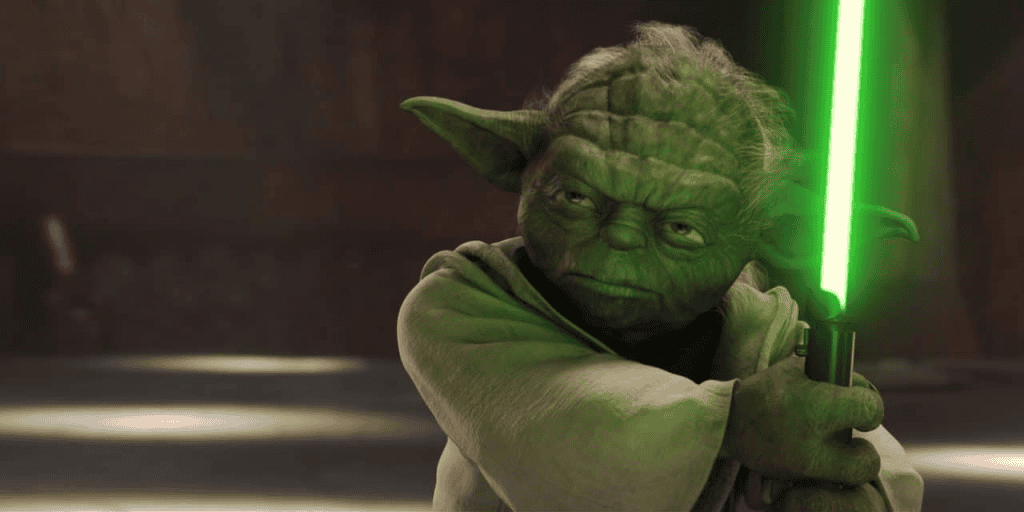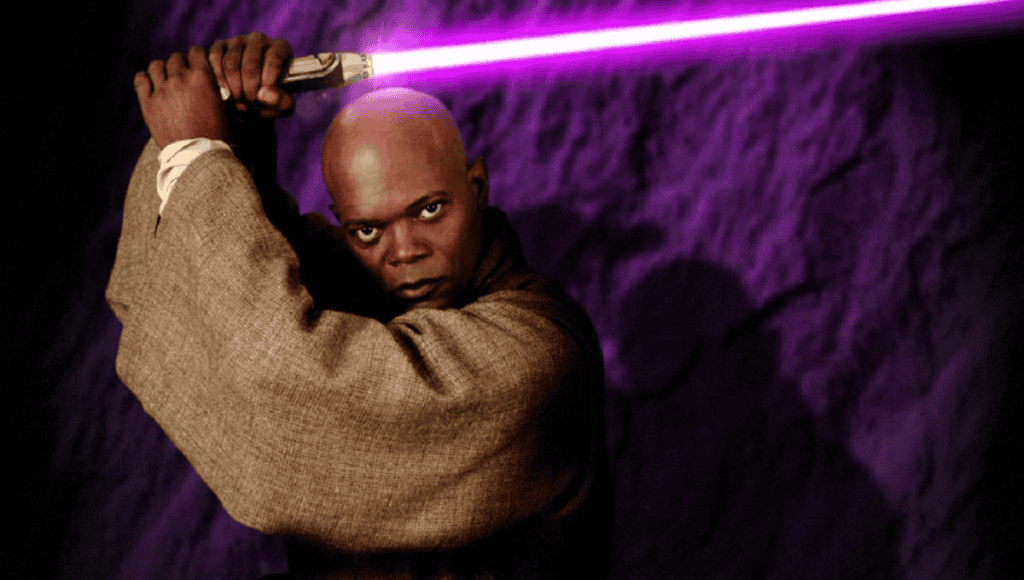Lightsabers are one of the greatest symbols of the Star Wars universe and, since the first film, have represented the struggle between good and evil, as well as each character’s connection to the Force. What many don’t know is that the color of the blade is not random. Each has a specific meaning, reflecting the personality, role, and even trajectory of the Jedi or Sith who wields it.
Created from Kyber crystals, rare, Force-sensitive minerals, sabers connect spiritually with their owners. This connection is so profound that it directly influences the tone and energy of the blade, making each saber unique. In other words, the color reflects who the bearer is inside, their balance, their choices, and the side of the Force they identify with most.
Behind the colored blades lies a symbolic and even philosophical meaning. From heroic blue to dark red, passing through rarer tones such as purple, white and yellow, each color brings with it its own story within the mythology of the saga. Check out the definition of each of them below.
Discover the meaning of each color of the Star Wars lightsabers
Lightsabers are weapons composed of a blade of pure energy, powered by a Kyber crystal that channels the Force of the wielder. More than combat tools, they represent the spiritual bond between the user and the Universe, as a symbol of identity and purpose.
Among the Jedi, crafting your own saber is a rite of passage, marking the end of learning and the beginning of maturity as a knight.
Among the Sith, the process is completely different. Once the crystals are corrupted with hatred and power, the blades end up turning red, reinforcing the idea that the saber reflects the inner state of its wielder. Every detail, be it the color, the sound or the way of fighting, has a personal meaning.
Blue

The blue saber is the most classic and recognizable of the entire saga. He is associated with the Jedi Guardians, those who prioritize combat and upholding peace, such as Obi-Wan Kenobi and Anakin Skywalker in his youth.
This color represents courage, boldness and justice, symbolizing commitment to action and confrontation with evil, being the saber of those who fight on the front lines and believe that force must be used to protect.
Furthermore, blue conveys balance between reason and emotion, reinforcing the idea of discipline and loyalty. In the expanded universe, he is related to warriors who rely more on their physical abilities than manipulation of the Force. Therefore, to see a blue saber in action is to see the essence of the traditional Jedi, determined, ethical and ready to act when necessary.
Green

The green saber represents wisdom, serenity and a deep connection with the Force. It is the color used by Jedi who prefer diplomacy to battle, such as Yoda, Qui-Gon Jinn and Luke Skywalker in his mature phase. These bearers believe that true power lies in understanding and balance, and not just brute force, and are therefore the tone of the galaxy’s masters, philosophers, and mediators.
Behind the scenes of Star Wars mythology, green also symbolizes inner harmony and spiritual mastery. These Jedi tend to seek understanding before resorting to combat, but when they do so they demonstrate tremendous mastery of the Force. Therefore, the green saber is a reflection of those who align with nature, wisdom and patience, which are key traits in maintaining the balance of the universe.
Red

The red saber is the symbol par excellence of the dark side of the Force. It is wielded by Sith such as Darth Vader, Darth Maul, and Kylo Ren and is born from the corruption of Kyber crystals, in a process known as “bleeding”. This practice causes the crystal to turn red, reflecting the wearer’s hatred, fear, and desire for power, like a blade born of pain and domination.
More than just a color, red symbolizes intensity, passion and destruction. It represents the intentional choice to upset the balance of the Force and give in to emotions. Each strike of the red saber brings with it arrogance and anger, becoming the visual signature of the enemies of peace. In the mythology of the saga, this color constantly reminds us of the price of ambition.
Viola

Rare and mysterious, the purple saber is the symbol of ambiguity. Its primary bearer is Mace Windu, a Jedi master who balances light and shadow within himself. The color represents someone who dominates the light side, but is not afraid to understand the dark side, as a bridge between two extremes. This reflects above-average courage and emotional dominance, as well as a unique connection to the Force.
Purple combines the wisdom of blue with the intensity of red, creating a tone of unstable power and balance. It is used by those who follow their own path, without being completely bound by the rules of the Jedi Order. Therefore, the purple saber is the symbol of those who seek the good, but understand that the Force is complex and that control over it requires self-knowledge.
Yellow

The yellow saber is linked to the Jedi Sentinels, the level-headed warriors who combine wisdom and practical skill. They prefer to work in the shadows, as guardians and investigators, always defending the galaxy. Rey Skywalker wields a yellow saber at the end of the saga, representing a new era of balance and learning following the end of the Jedi-Sith war.
In addition to symbolizing vigilance and prudence, yellow also represents service and dedication. This color is common among the protectors of Jedi temples, figures who preserve knowledge and maintain order. Unlike more common colors, yellow reflects neutrality and observation, being the light of those who protect what is sacred, without needing to be at the center of the battle.
White

The white saber is the purest and most independent of all. It appears when a corrupted crystal is purified, as in the case of Ahsoka Tano, who purified Sith crystals and transformed them into white blades. This color symbolizes freedom from any ties to the Jedi Order or the dark side, representing an individual and authentic journey.
White also conveys clarity, balance and spiritual autonomy. He who wields a saber of this color does not fight for doctrines, but for his own principles. Ahsoka, for example, has become a symbol of wisdom and independence, proving that it is possible to serve the Force without being bound to separate parts. So white is the color of those who have transcended the conflict.
Black (Darksaber)

The Darksaber is an exception within the Star Wars mythology, and was created by Tarre Vizsla, the first Mandalorian Jedi, having a black blade with white edges and a different meaning from all others. The dark sword is not related to the light or dark side, but to political power and leadership. Whoever wields it is seen as the heir to a Mandalorian legacy.
In addition to representing authority, the Darksaber has historical and spiritual weight. It is passed down from generation to generation, conquered in combat, and treated as a symbol of honor and dominance. Its dark color symbolizes mystery, tradition and the weight of power, and it is more than a weapon: the dark sword is a reminder that the Force also manifests itself in cultural heritage and the struggle for identity.
The post Do you like Star Wars? Discover the meaning of the color of each lightsaber first appeared on Olhar Digital.
Source: Olhar Digital
Rose James is a Gossipify movie and series reviewer known for her in-depth analysis and unique perspective on the latest releases. With a background in film studies, she provides engaging and informative reviews, and keeps readers up to date with industry trends and emerging talents.




![A More Beautiful Life in Advance: Jennifer Gets Lost in the Feelings… What’s in store for the week of October 27 – October 31, 2025 [SPOILERS] A More Beautiful Life in Advance: Jennifer Gets Lost in the Feelings… What’s in store for the week of October 27 – October 31, 2025 [SPOILERS]](https://fr.web.img6.acsta.net/img/da/bf/dabf67a32e462c255362445e30b8ae1c.jpg)



